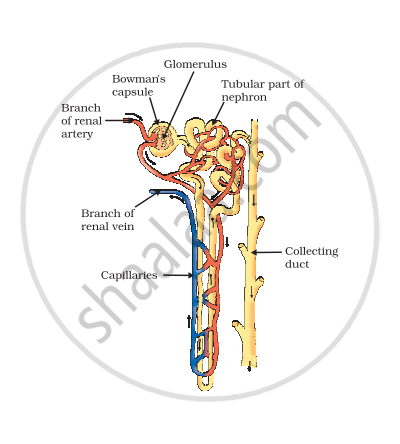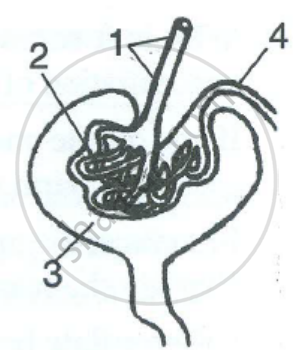Advertisements
Advertisements
Question
Describe the structure and functioning of nephrons.
Solution
Nephrons are the basic filtering units of kidneys. Each kidney possesses a large number of nephrons, approximately 1-1.5 million. The main components of the nephron are the glomerulus, Bowman’s capsule, and a long renal tubule.

Functioning of a nephron:
- The blood enters the kidney through the renal artery, which branches into many capillaries associated with the glomerulus.
- The water and solute are transferred to the nephron at Bowman’s capsule.
- In the proximal tubule, some substances such as amino acids, glucose, and salts are selectively reabsorbed and unwanted molecules are added to the urine.
- The filtrate then moves down into the loop of Henle, where more water is absorbed.
- From here, the filtrate moves upwards into the distal tubule and finally to the collecting duct. The collecting duct collects urine from many nephrons.
- The urine formed in each kidney enters a long tube called the ureter. From the ureter, it gets transported to the urinary bladder and then into the urethra.
RELATED QUESTIONS
Why is it necessary to excrete waste products?
the Biological/technical term Pigment providing colour to urine.
The diagram given below shows a section of human kidney. Study the diagram carefully and answer the questions that follow :

(i) Label the parts numbered 1 to 4.
(ii) Why does part ‘2’ have a striped appearance?
(iii) What is the fluid that passes down part ‘4’? Name the main nitrogenous waste present in it.
(iv) Mention the structural and functional units of kidneys.
(v) Name the two major steps in the formation of the fluid mentioned in Q.5 (a) (iii).
Write the functions of Ureter
Define excretion
Differentiate between the following pair on the basis of what is indicated in the bracket.
Ureter and Urethra [function]
State whether the following statement is true or false:
Some organisms store wastes in body parts.
Name the two waste products of the human body which are produced in the body cells.
A dialysis machine contains long tubes coiled in a tank containing dialysing solution Of what substance are the tubes made?
A dialysis machine contains long tubes coiled in a tank containing dialysing solution
What does the dialysing solution contain?
How are waste products excreted in Amoeba?
In which of the following are the largest amounts of nitrogen excreted from a mammalian body?
(a) breath
(b) sweat
(c) urine
(d) faeces
The procedure of cleaning the blood of a person by using a kidney machine is known as:
(a) ketolysis
(b) hydrolysis
(c) dialysis
(d) photolysis
The excretory organs in an earthworm are:
(a) nephridia
(b) nephrons
(c) raphides
(d) ureters
Fill in the blank :
Nitrogenous wastes in the urine are in the form of urea and .....................
State if the following statement is true or false. Correct the statement if it is false.
Liver produces bile pigments from the hemoglobin of broken RBCs.
Tick the most appropriate answer.
The process of removing waste from the body is called
Tick the most appropriate answer.
Quinine is used in the treatment of
Fill in the blank.
....................... are present in the stem of pine tree that make the pinewood strong and durable.
Differentiate between
tannins and resins
Answer the following in detail.
Describe the process of urine formation.
In humans, urea is formed in
Name the following:
The tuft of capillaries inside the Bowman's capsule.
Given below is a set of five terms. Rewrite the terms in their correct order so as to be in logical sequence.
Afferent arteriole, renal vein, secondary capillary network, glomerulus, efferent arteriole.
Differentiate between the following pairs of term :
Renal pelvis and renal papilla
Fill in the blanks in the following passage to make it a meaningful description.
In a nephron, the ______ flows through the ______ under great pressure. The reason for this great pressure is that the ______ (outgoing) ______ is narrower than the ______ (incoming). This high pressure causes the ______ part of the blood to filter out from the ______ into the ______ capsule.
Choose the odd one out in the following serie:
Column of Bertini, minora calyces, brain.
Study the diagram given alongside and then answer the question that follow:

Name the parts labelled 1, 2, 3, and 4.
Differentiate between:
The Renal artery and the Renal vein.
Name the Following
The blood vessels which brings pure blood to the kidneys:
State the Location: Renal pyramids
Choose the Odd One Out:
Choose the correct option.
Visceral layer : Podocytes :: PCT : ________.
Choose the correct option.
The part of nephron which absorbs glucose and amino acid is ______.
Identify the INCORRECT match.
Osmoregulation maintains the osmolarity of blood at about ______.
In order to maintain homeostasis or constant internal environment . ______' is essential.
Elimination of nitrogenous wastes in the form of uric acid takes place in ____________.
In a person the tubule part of the nephron is not functioning at all. What will its effect be on urine formation?
Give two examples of the following:
Bile pigments
